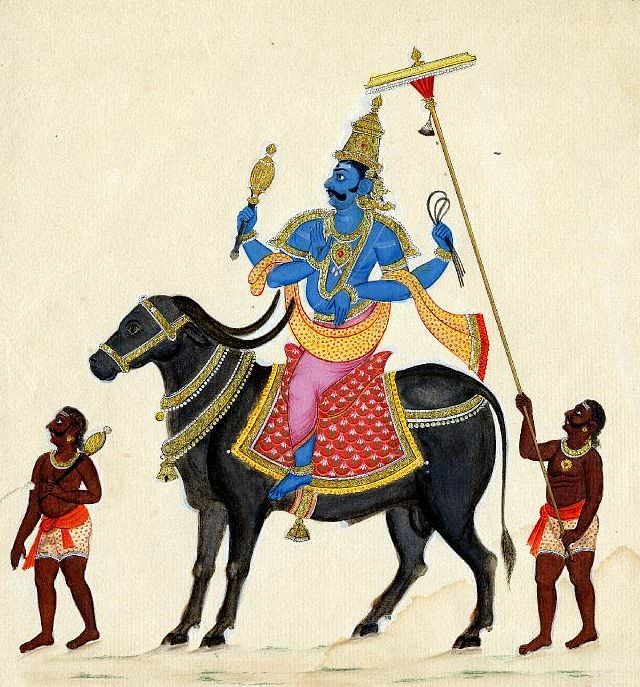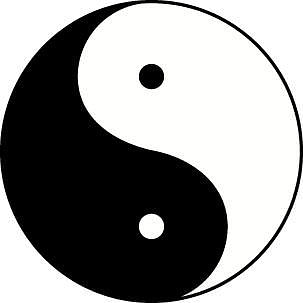Yama › Yin and Yang » Ancient origins
Articles and Definitions › Contents
- Yama › Who Was
- Yin and Yang › Antique Origins
Ancient civilizations › Historical and archaeological sites
Yama › Who Was
Definition and Origins

Yama is the Hindu god of death, king of ancestors, and final judge on the destination of souls. He is also known as the 'Restrainer', Pretaraja or 'King of Ghosts', Dharmaraja or 'King of Justice', and as Daksinasapati is considered the regent of the South Quarter. Yama may also be referred to simply as 'Death' – Antaka, Kala or Mrtyu. Due to his responsibility for good decision-making based on records of a person's deeds, the god is particularly associated with the rule of law. Yama is also present in Iranian mythology, traditional Chinese and Japanese mythology, and elements of Buddhism.
YAMA'S FAMILY RELATIONS
Yama is the son of the sun god Vivasvat (or Visvavasu in other versions) and his mother is Saranyu-Samjna (Conscience). He is the brother of Manu or Vaivasvata and he also has a twin sister, Yami (or Yamuna). Yama and Yami are, in some myths, the first humans and creators of the human race but in other versions Yama is the first human to die and so the first to pass into the next world. Yama is considered the father of Yudhisthira, one of the five Pandu princes. His wives are Hemamala, Vijaya, and Susila.
YAMA AS JUDGE OF SOULS
Unlike the god of the dead or the underworld in other cultures, Yama is not always described as a punisher of the wicked. The god is feared by some, though, especially because of his two great hounds. These fearsome creatures have four eyes and they guard the path which the dead must take to reach Yama. The dogs are sometimes sent to the world of the living in order to beckon souls to Yama. In other versions, a bird performs this duty, calling the dead to the god's city of Yamapura, deep in the murky underworld. In yet another version, Agni (the Hindu god of fire and son of Yama and Yami) leads the dead to Yama.
THE GOOD WILL ENJOY ETERNAL HAPPINESS AND SHINE AS STARS IN THE CELESTIAL HEAVENS
When souls arrive in Yama's Kalici palace, they are first met by Yama's porter Vaidhyata and then two attendants Kalapurusa and Chanda (or Mahachanda) usher them to an audience with the great god. First, their worldly deeds are read out by Yama's scribe Citragupta, who consults a massive register, the Agrasandhani. Based on this evidence Yama sits on his throne of judgement (Vicarabhu) and considers the three options he has at his disposal. The first and best is to be given immortality by drinking soma and sent to live forevermore with the wise and saintly pitrs or Manes, to whom Yama is king. Here the good will enjoy eternal happiness and shine as stars in the celestial heavens. The second option is to be sent back into the world and be reborn in order to, as it were, have another go at leading a good life, although not necessarily as a human. The third and worst option is to be sent down into the 21 levels of hell; the lower the level, the worse the punishment.
YAMA'S CURSE
Yama appears in an unflattering episode in the Puranas. Attempting to kick his mother Samjna (or in another version Chaya, one of his father's maids), Yama succeeded only in receiving a curse from his would-be victim. He was condemned to have a terribly wounded leg which never healed and became infested with maggots. Fortunately for Yama, his father gave him a cock which ate all the vermin in his leg and eventually he recovered, even if his permanently damaged leg thereafter gained him the name of Sirnapada or 'shrivelled foot'.
YAMA IN ART
In Hindu art, Yama is often portrayed with green or blue skin and wearing red robes. His vehicle is a buffalo (or elephant) and he often carries a mace or rod --which was made from a part of the sun-- and a noose, the latter symbolic of his role as a catcher of souls. Indeed, he is sometimes known as Pasi, 'the noose-carrier'.
In Tibet, where Yama is known as Gsin-rje, the god is often represented with a demonic face and viciously stamping on somebody. Yama appears in similar pose on reliefs at Angkor Wat, Cambodia. Finally, he is a familiar statue figure in many Chinese temples where he is known as Yen-lo wang.
Yin and Yang › Antique Origins
Definition and Origins

The principle of Yin and Yang is that all things exist as inseparable and contradictory opposites, for example, female-male, dark-light and old-young. The principle, dating from the 3rd century BCE or even earlier, is a fundamental concept in Chinese philosophy and culture in general. The two opposites of Yin and Yang attract and complement each other and, as their symbol illustrates, each side has at its core an element of the other (represented by the small dots). Neither pole is superior to the other and, as an increase in one brings a corresponding decrease in the other, a correct balance between the two poles must be reached in order to achieve harmony.
ORIGIN
The concept of Yin and Yang became popular with the work of the Chinese school of Yinyang which studied philosophy and cosmology in the 3rd century BCE. The principal proponent of the theory was the cosmologist Zou Yan (or Tsou Yen) who believed that life went through five phases ( wuxing ) - fire, water, metal, wood, earth - which continuously interchanged according to the principle of Yin and Yang.
WHAT IS YIN?
Yin is:
- feminine
- black
- dark
- north
- water (transformation)
- passive
- moon (weakness and the goddess Changxi)
- earth
- cold
- old
- even numbers
- valleys
- poor
- soft
- and provides spirit to all things.
Yin reaches it's height of influence with the winter solstice. Yin may also be represented by the tiger, the colour orange and a broken line in the trigrams of the I Ching (or Book of Changes ).
WHAT IS YANG?
Yang is:
- masculine
- white
- light
- south
- fire (creativity)
- active
- sun (strength and the god Xihe)
- heaven
- warm
- young
- odd numbers
- mountains
- rich
- hard
- and provides form to all things.
Yang reaches it's height of influence with the summer solstice. Yang may also be represented by the dragon, the colour blue and a solid line trigram.
IN MYTHOLOGY & RELIGION
IN CHINESE MYTHOLOGY YIN & YANG WERE BORN FROM CHAOS WHEN THE UNIVERSE WAS FIRST CREATED.
In Chinese mythology, Yin and Yang were born from chaos when the universe was first created and they are believed to exist in harmony at the centre of the Earth. During the creation, their achievement of balance in the cosmic egg allowed for the birth of Pangu (or P'an ku), the first human. In addition, the first gods Fuxi, Nuwa and Shennong were born from Yin and Yang. In Chinese religion, the Taoists favour Yin whilst Confucianists favour Yang in keeping with the prime focus of their respective philosophies. The Taoists emphasize reclusion whilst Confucianists believe in the importance of engagement in life.
As expressed in the I Ching, the ever-changing relationship between the two poles is responsible for the constant flux of the universe and life in general. When there is too great an imbalance between Yin and Yang, catastrophes can occur such as floods, droughts and plagues.
LICENSE:
Article based on information obtained from these sources:with permission from the Website Ancient History Encyclopedia
Content is available under License Creative Commons: Attribution-NonCommercial-ShareAlike 3.0 Unported. CC-BY-NC-SA License